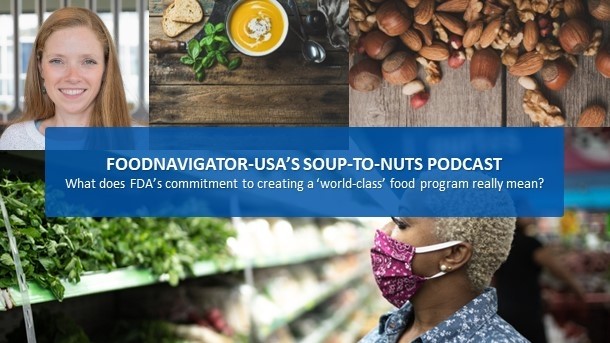Soup-To-Nuts Podcast: What does FDA’s commitment to ‘building a world-class human foods program’ mean for industry?

FDA Commissioner of Food and Drugs Robert Califf was quick admit that the agency’s food program in recent years “has been stressed by the increasing diversity and complexity of the nation’s food systems and supply chain, the ongoing impacts associated with climate change and rapid advances in the science underlying many of the foods we eat today.”
But, he added, redesigning a more effective human foods program “is a top priority for the agency,” and by the end of January he said FDA will offer a new vision for the program and by the end of February will outline the program’s leadership structure and any changes to key internal processes and procedures.
His commitment to speed underscores the gravity of the report’s findings and the urgency of addressing shortcomings, which critics say have contributed to food shortages and recalls due to safety concerns. But it also leaves unanswered, for now, what a redesigned human foods program might look like, what it will prioritize and how potential changes might impact the food and beverage industry.
In this episode of FoodNavigator-USA’s Soup-To-Nuts Podcast, former FDA regulatory counsel Jonathan Havens, who is now the co-chair of Saul Ewing’s cannabis law and food, beverage and agribusiness practices, takes a deep dive into the Reagan-Udall report’s recommendations to tease out potential answers, including how the human food program could be restructured, possible changes to enforcement and nutrition policy development, and how a shakeup could impact industry.
He also shares what the next few months may hold and what stakeholders can do now to help shape the future they want.
[Editor’s note: Never miss an episode of FoodNavigator-USA’s Soup-To-Nuts podcast – subscribe today.]
Recommendation to separate oversight of food from drugs isn’t new – but will it stick this time?
Among the sweeping recommendations by the Reagan-Udall Foundation to elevate the visibility of food within the FDA is to separate its oversight from that of the drug industry – or at the very least appoint a single, clearly identified leader with direct lines of authority over all safety and applied nutrition program components.
While this idea was lauded by many industry players, Havens explains this is not the first time such a shift has been suggested … and it may not be the last time given the difficulty of dividing the agency and the many stakeholders that would need to be involved and hurdles overcome. But that doesn’t mean the agency will remain as it is.
“This is not the first time that there has been a proposal advanced to separate the food regulatory function from FDA completely out of the agency, right? We’ve heard this federal food commission concept before, but it has, of course, not advanced to the point where that function has actually been moved out of the FDA,” Havens said.
“And there are a lot of reasons that we could talk about why that is, and why food has not received the attention” that other products regulated by FDA have, such as medical products, he added.
Among these are the need for Congressional action, the daunting amount of work it would take to restructure the agency, questions about funding and staffing, the risk of losing institutional knowledge, and just the fact that Washington is a bit like a large ship that requires time to turn around, said Havens.
Acknowledging that many of these reasons “aren’t good,” he noted that this time might be different because FDA Commissioner Califf was the one who called for change – suggesting an openness within government to the idea that might not have been there before.
What might a new human foods program look like?
Potentially reorganizing the human food program won’t be an easy task given how various components of the program currently are spread across four parts of the FDA, including the Center for Food Safety and Applied Nutrition, the Office of Food Policy, the Center for Veterinary Medicine and portions of the Office of Regulatory Affairs.
Of these, CFSAN’s and OFP’s missions are most closely aligned – which Havens says may sound good in theory until you realize the duplications are inefficient and the approaches each group takes to the same challenge may differ in ways that are counterproductive.
“When we talk about how food is currently regulated at FDA, it is regulated in four different ways. But I would focus on OFP and CFSAN to say there are two groups within FDA that are doing not completely similar things, but there’s a lot of overlap,” and so when a problem arises and you need “coordinated, quick, decisive action,” there isn’t a dedicated leader to point the agency in one direction, Havens said.
Fragmented staff, overlapping roles … and lack of communication
He added there are a lot of smart and well-intentioned employees at FDA and the turmoil created by the agency’s structure isn’t their fault, “but this absence of a unifying mission and definition of the human foods program has led to, among other things, as the report suggests, fragmented staff, overlapping roles … and lack of communication.”
With this in mind, The Reagan-Udall report suggested five potential ways to restructure the human foods program – some of which Havens says would be easier and take less time to execute than others.
The first option is to create a separate food administration within the Department of Health and Human Services that would integrate all the parts of the food program currently scattered about FDA under one center. This option would require congressional action and likely would be the most time consuming of all the options.
The second option is to separate medical and food products within FDA and establishing a dedicated foods center that would elevate human food within FDA and integrate the food portions of the current setup. FDA has authority to do this, which means it wouldn’t require as much time as the first option.
The third option would designate CFSAN as the lead for the foods program, which would take even less time but might bruise some egos as it could be seen as a demotion for OFP.
The fourth would separate CFSAN and ORA, which Havens notes is already the case.
The last suggestion is to create a deputy commissioner for foods tasked with oversight of the program, which Havens said “would certainly help lead the charge” and checks all the boxes except creating a separate human foods program budget.
So, what is the best option?
The general consensus, according to a letter sent to Califf by the Consumer Brands Association, Consumer Reports and other industry stakeholders, seems to be creating a deputy commissioner for foods – which can be done without an act of Congress and with minimal upfront disruption to industry -- or separating medical and food products to establish a dedicated foods center. These don't preclude later acting on one of the other options, but Havens admits he is skeptical.
“I tend to vote on incremental change when it comes to FDA and Washington, than on massive, sweeping change. So, I think a separate Food Administration to me seems not all that likely,” and maybe not even necessary given the main goal is to increase coordination, Havens said.
He also noted that getting Congressional agreement and action for massive restructuring adds another layer of challenge and potential for disruption that doesn’t necessarily address the current challenges in a way that is significantly more meaningful.
“Something that FDA needs to think about here is fixing the problems that we’ve talked about, but not doing it in a way that’s going to disrupt the agency’s continuing work and not disrupt industry’s expectations,” he added.
Nutrition policy increasingly viewed as important as food safety
In addition to streamlining and coordinating oversight of human food, the Reagan-Udall report also suggests creating a Center for Nutrition that would elevate the importance of nutrition, which currently often plays second fiddle to safety. Such a move would potentially enhance the government’s ability to encourage Americans to adopt healthier diets, but as Havens notes this is would require carefully balancing rights and priorities.
He explains that the US values consumer choice, including what to eat and drink, but if people continue to choose the least healthy option the government and tax payers end up footing a larger bill for Medicare and Medicaid – creating a tension that is difficult to address.
However, he added, in recent years the FDA and Congress have acted to improve nutrition education, such as through more completely labelling and banning certain ingredients, so there is a precedent for this type of oversight.
“I will be curious to see if and when FDA creates a new Center for Nutrition what the policies that come out of the center are,” and if industry will need to act differently either by using different ingredients or labelling things in a certain way, he said.
Changes in enforcement could be win-win
Depending on if or how FDA realigns its human food program, industry could see changes in how the agency approaches enforcement – but as Havens notes, this isn’t necessarily bad. In fact, some of the suggestions in the Reagan-Udall report could simplify the inspection process and maybe even result in fewer site visits.
He explains that the Reagan-Udall report recommended leveraging records requests for more remote inspections so that FDA inspectors can review information before or instead of visiting a site for a more efficient process.
“if records can be shared ahead of time, it would help the company prepare, help FDA prepared and maybe it would obviate the need for an inspector to even be on site if they’re not inspecting physical machinery, equipment and those sorts of things, if records are what they are after. So, this is something that I hope is positive development,” Havens said.
But he added, a big caveat is having FDA and industry agree one what records requests are ‘reasonable’ and ensuring that the agency doesn’t overreach.
The time to get involved is now
With the potential for so much change on the table, Havens encourages industry to take an active role in helping to reshape FDA’s human food program by reaching out directly or working with trade groups to work with the agency, and if necessary, Congress to ensure their preferences and needs are considered.
“You could wait to see what FDA announces at the end of January in February. I certainly think there's conversations that stakeholders can be having either individually or through trade associations that they belong to. And we've already seen several leading food trade associations, respond to the report and respond to FDA’s response to the report. I think they've all been encouraging in terms of this is good, let's see where we go with this. But I don't think it's too early to have conversations with FDA,” Havens said.
He added that he also doesn’t think it is a bad idea for stakeholders to be open with Congressional leaders and educate them on the issues so that if they are involved their actions and expectations of industry are reasonable.
A good starting point for taking action is to read the Reagan-Udall report. And, of course, FoodNavigator-USA will keep you posted about developments, including updates from FDA in the coming months.
















